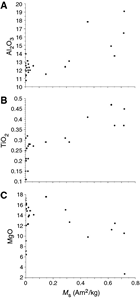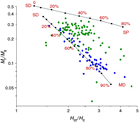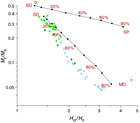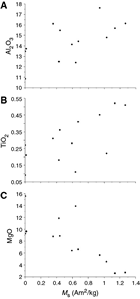Reagan, M.K., Pearce, J.A., Petronotis, K.E., and the Expedition 352 Scientists
Proceedings of the International Ocean Discovery Program Volume 352
publications.iodp.org
doi:10.14379/iodp.proc.352.201.2017
Data report: hysteresis properties of igneous rocks from Holes U1439C, U1440B, and U1442A1
Claire Carvallo2
Keywords: International Ocean Discovery Program, IODP, JOIDES Resolution, Expedition 352, Izu-Bonin-Mariana Fore Arc, Site U1439, Site U1440, Site U1442, hysteresis parameters, rock magnetism
MS 352-201: Received 16 June 2016 · Accepted 11 November 2016 · Published 31 January 2017
Abstract
Hysteresis loops and direct current backfield curves were measured on 146 samples from Hole U1439C, 54 samples from Hole U1440B, and 56 samples from Hole U1442A, which were cored during International Ocean Discovery Program Expedition 352. Saturation magnetization values correlate fairly well with the downhole lithology. For samples from Holes U1439C and U1442A, hysteresis parameters plot in different regions of the Day plot depending on whether their composition is boninitic or andesitic. Similarly in Hole U1440B, samples from the various petrologic units plot have different hysteresis parameters. The results show that the magnetic mineralogy varies strongly within each hole.
Introduction
International Ocean Discovery Program (IODP) Expedition 352 took place August–September 2014 and was aimed at studying oceanic crustal accretion immediately following subduction initiation by drilling into the Izu-Bonin-Mariana (IBM) fore arc. The IBM system is sufficiently old that it carries a full record of the evolution of crustal accretion from the start of subduction to the start of normal arc volcanism and sufficiently young that the key features have not been excessively disturbed by subsequent erosion or deformation. Expedition 352 successfully cored 1.22 km of igneous basement and 0.46 km of overlying sediment, providing diverse, stratigraphically controlled suites of fore-arc basalt (FAB) and boninites related to seafloor spreading and earliest arc development. FAB and related rocks were recovered at the two deeper water sites (U1440 and U1441), and boninites and related rocks were recovered at the two sites drilled upslope to the west (Sites U1439 and U1442). Holes U1439C and U1442A yielded entirely boninite differentiation–series lavas that generally become more primitive and have lower TiO2 concentrations uphole.
Thermal and alternating field (AF) demagnetizations were carried out by the shipboard paleomagnetists on discrete samples in order to give an estimate of the inclination of the recorded geomagnetic field. These shipboard results were reported in the Paleomagnetism sections of each site chapter. In order to carry out more detailed paleomagnetic studies, more samples were collected as paleomagnetic cubes or minicores in Holes U1439C, U1440B, and U1440A for thermal and AF demagnetizations to be carried out on shore. To better understand the magnetic mineralogy of the sampled flows, a slice of sample from the bottom of each cube or minicore was collected for hysteresis measurements. Some results will be presented in Carvallo et al. (in prep.), but that study will focus on a few samples that were selected for the paleointensity study. Hysteresis measurements were subsequently made on the larger suite of samples and are presented here.
Methods and materials
Hysteresis measurements were carried out at Institut de Physique du Globe de Paris–Institut de Minéralogie, de Physique des Matériaux et de Cosmochimie (IPGP-IMPMC) Mineral Magnetism Analytical Facility with a magnetometer (µ-VSM) from Princeton Measurements Corporation. A millimeter-size chip (between 100 and 800 mg) was fixed on the probe with grease. A maximum field of 1 T was applied, and the averaging time was 100 ms. When the magnetization was weak (as it is often the case for boninite) and therefore the hysteresis loops were noisy, between 5 and 20 loops were then measured and averaged together. Hysteresis loops were corrected for the diamagnetic and paramagnetic contribution, and the remanent magnetization (Mr), saturation magnetization (Ms), and coercivity field (Hc) parameters were calculated from the corrected loops. Backfield direct current curves were also measured for each sample in order to obtain the remanent coercivity field (Hcr).
Results
Hole U1439C
A total of 146 hysteresis parameters were measured for samples from Hole U1439C. Results are summarized in Table T1. All parameters span a very large range. For instance, Ms values span 3 orders of magnitude, from 10–3 to 1 Am2/kg, and Hc ranges from 2 to 35 mT. When plotted downhole, Mr and Ms values show some correlation with petrologic units (Figure F1A, F1B). These values are the highest in Units 5, 7, 8b, and 10 and in some parts in Units 6 and 8c. This also corresponds to where onboard bulk magnetic susceptibility was found to be highest. Units 7, 8b, and 10 correspond to andesite, but the high values found in the boninite units could be caused by secondary alteration (see Petrology in the Site U1439 chapter [Reagan et al., 2015a]). Hc and Hcr values do not show such a correlation with the petrologic units (Figure F1D, F1F). Because of this correlation between Ms and lithology, Ms as a function of the MgO, TiO2, and Al2O3 concentrations from the portable X-ray fluorescence measurements carried out on board was also plotted for samples as close as possible (≤60 cm) to samples used for hysteresis measurement. Ms seems to be higher when Al2O3 and TiO2 concentrations are higher and MgO concentrations are lower (Figure F2).
A few samples have a very low Mr/Ms ratio (<0.050), but most of them are between 0.050 and 0.350. Some Hcr/Hc ratios are very high, but they correspond to very weak samples and therefore might not be reliable. The hysteresis parameters were plotted on a Day plot (Day et al., 1977) with Dunlop (2002) mixing lines and were separated into two categories: weak samples (Ms < 0.1 Am2/kg) and strong samples (Ms > 0.1 Am2/kg). These two categories plot in different regions on the Day plot. The strong samples follow the single-domain–multidomain (SD–MD) mixing line, but the weak samples are between the SD–MD and single-domain–superparamagnetic (SD–SP) mixing line, suggesting that the two groups have different magnetic mineralogies (Figure F3).
Hole U1440B
Fifty-four hysteresis parameters were measured on samples from Hole U1440B. Results are summarized in Table T2. Ms values are strong, between 0.3 and 2 Am2/kg (except for one very weak sample that might have been misnamed). The hysteresis parameters show fairly good correlation with the petrologic units defined in the Site U1440 chapter (Reagan et al., (2015b) (Figure F4). Mr values are higher in the volcanic extrusive zone than in the dikes zone, while it is the opposite for Ms (Figure F4A, F4B). Hc and Hcr also follow this tendency on average, and Hcr/Hc ratios are higher in the dikes zone than in the volcanic extrusive zone (except for the suspicious sample with a very low saturation magnetization) (Figure F4D, F4F). When plotted on a Day plot, the samples from the three different units plot in three different regions (Figure F5), slightly below the SD–MD mixing line; the volcanic extrusive samples have 60%–100% SD grains, whereas the samples from the dikes unit contain between 10% and 60% SD grains. The compositions of samples from the transition zone are intermediate between these two zones.
Hole U1442A
Fifty-six hysteresis loops were measured on samples from Hole U1442A. As expected, the hysteresis parameter values show a large spread, similar to what was observed for Hole U1439C (Table T3). Correlation with the lithology is not as clear as for the other two holes (Figure F6). Ms and Mr values seem to be higher in Unit 2, where dikes could be present among boninite. The very high Hcr/Hc ratios come from very weak and noisy samples and therefore have to be regarded with caution. As for Hole U1439C, it is possible to plot Al2O3, TiO2, and MgO concentrations as a function of saturation magnetization (Figure F7). Again, a slight correlation appears: Ms is higher where samples contain more TiO2 and Al2O3 and lower where samples contain more MgO; although this correlation does not appear as clearly as for Hole U1439C. For the Day plot representation (Figure F8), samples are again divided into two groups: weak samples (Ms < 0.1 Am2/kg) and strong samples (Ms > 0.1 Am2/kg). The difference in hysteresis parameters between the two groups is not as clear as for Hole U1439C. Strong samples have a tendency to plot slightly closer to the SD–MD mixing line than the weak samples, showing again the difference in magnetic mineralogy between the two groups.
Acknowledgments
This research used samples and data provided by the International Ocean Discovery Program (IODP). IODP France is acknowledged with funding support. I thank F. Lagroix for her help with the measurements, an anonymous reviewer for helpful comments, and IODP for receipt of samples.
References
Day, R., Fuller, M., and Schmidt, V.A., 1977. Hysteresis properties of titanomagnetites: grain-size and compositional dependence. Physics of the Earth and Planetary Interiors, 13(4):260–267. http://dx.doi.org/10.1016/0031-9201(77)90108-X
Dunlop, D.J., 2002. Theory and application of the Day plot (Mrs /Ms versus Hcr /Hc), 1. Theoretical curves and tests using titanomagnetite data. Journal of Geophysical Research: Solid Earth, 107(B3):2056. http://dx.doi.org/10.1029/2001JB000486
Reagan, M.K., Pearce, J.A., Petronotis, K., Almeev, R., Avery, A.A., Carvallo, C., Chapman, T., Christeson, G.L., Ferré, E.C., Godard, M., Heaton, D.E., Kirchenbaur, M., Kurz, W., Kutterolf, S., Li, H., Li, Y., Michibayashi, K., Morgan, S., Nelson, W.R., Prytulak, J., Python, M., Robertson, A.H.F., Ryan, J.G., Sager, W.W., Sakuyama, T., Shervais, J.W., Shimizu, K., and Whattam, S.A., 2015a. Site U1439. In Reagan, M.K., Pearce, J.A., Petronotis, K., and the Expedition 352 Scientists, Izu-Bonin-Mariana Fore Arc. Proceedings of the International Ocean Discovery Program, 352: College Station, TX (International Ocean Discovery Program). http://dx.doi.org/10.14379/iodp.proc.352.103.2015
Reagan, M.K., Pearce, J.A., Petronotis, K., Almeev, R., Avery, A.A., Carvallo, C., Chapman, T., Christeson, G.L., Ferré, E.C., Godard, M., Heaton, D.E., Kirchenbaur, M., Kurz, W., Kutterolf, S., Li, H., Li, Y., Michibayashi, K., Morgan, S., Nelson, W.R., Prytulak, J., Python, M., Robertson, A.H.F., Ryan, J.G., Sager, W.W., Sakuyama, T., Shervais, J.W., Shimizu, K., and Whattam, S.A., 2015b. Site U1440. In Reagan, M.K., Pearce, J.A., Petronotis, K., and the Expedition 352 Scientists, Izu-Bonin-Mariana Fore Arc. Proceedings of the International Ocean Discovery Program, 352: College Station, TX (International Ocean Discovery Program). http://dx.doi.org/10.14379/iodp.proc.352.104.2015
Reagan, M.K., Pearce, J.A., Petronotis, K., Almeev, R., Avery, A.A., Carvallo, C., Chapman, T., Christeson, G.L., Ferré, E.C., Godard, M., Heaton, D.E., Kirchenbaur, M., Kurz, W., Kutterolf, S., Li, H., Li, Y., Michibayashi, K., Morgan, S., Nelson, W.R., Prytulak, J., Python, M., Robertson, A.H.F., Ryan, J.G., Sager, W.W., Sakuyama, T., Shervais, J.W., Shimizu, K., and Whattam, S.A., 2015c. Site U1442. In Reagan, M.K., Pearce, J.A., Petronotis, K., and the Expedition 352 Scientists, Izu-Bonin-Mariana Fore Arc. Proceedings of the International Ocean Discovery Program, 352: College Station, TX (International Ocean Discovery Program). http://dx.doi.org/10.14379/iodp.proc.352.106.2015
1 Carvallo, C., 2017. Data report: hysteresis properties of igneous rocks from Holes U1439C, U1440B, and U1442A. In Reagan, M.K., Pearce, J.A., Petronotis, K.E., and the Expedition 352 Scientists, Izu-Bonin-Mariana Fore Arc. Proceedings of the International Ocean Discovery Program, 352: College Station, TX (International Ocean Discovery Program). http://dx.doi.org/10.14379/iodp.proc.352.201.2017
2 Institut de Minéralogie, de Physique des Matériaux et de Cosmochimie, UPMC Univ Paris 06, UMR CNRS 7590, MNHN, IRD UMR 206, 4 Place Jussieu, F-75005 Paris, France. carvallo@impmc.upmc.fr
This work is distributed under the Creative Commons Attribution 4.0 International (CC BY 4.0) license. 








